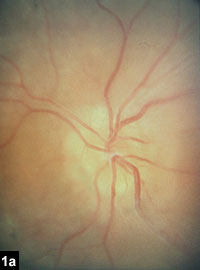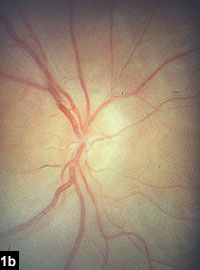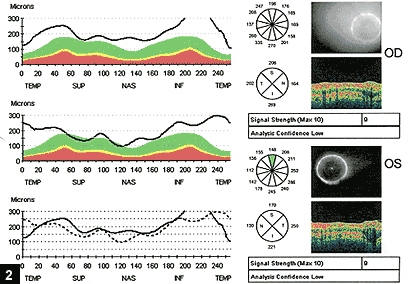Patient presents with worsening hyperopia and rising IOP
Funduscopic exam showed bilateral crowded optic nerve heads, and OCT of the retinal nerve fiber layer showed abnormally thick measurements.
|
| ![Zinaria Williams, MD [photo]](/~/media/images/news/print/ocular-surgery-news/2006/05_may_15/williams_70_90_16845.jpg) Zinaria Williams |
A 45-year-old white woman was referred to the glaucoma service at the New England Eye Center for evaluation and management of gradually increasing IOP in both eyes. According to the patient, she has always needed corrective lenses, and although her vision could be corrected to “near perfect,” her hyperopia has continued to increase with age. At a recent eye exam, her optometrist noted IOP of 25 mm Hg in the right eye and 28 mm Hg in the left eye. These pressures had been increasing over the past few visits, and she was referred for further care and management.
Medical history
The patient’s ocular and medical history was otherwise unremarkable, and she was on no medications. No family history was available because the patient was adopted.
Examination
Best corrected visual acuity was 20/25 in the right eye and 20/40 in the left, with manifest refraction of +17.00 –0.50 × 135 in the right eye and +19.00 –1.25 × 010 in the left. Central corneal thickness was 623 nm in the right eye and 643 nm in the left. Applanation tensions were 26 mm Hg in the right eye and 27 mm Hg in the left. Pupils were equal and reactive. Confrontational visual fields showed slight peripheral constriction in both eyes. On slit lamp examination, the patient’s orbits were relatively close set, with markedly small palpebral fissures. There were no cells present in the anterior chambers or vitreous. Gonioscopy revealed angles open 360· to the posterior trabecular meshwork. Funduscopic examination of the right (Figure 1A) and left (Figure 1B) eyes showed bilateral crowded optic nerve heads, with some blurriness of the disc margins. Optical coherence tomography of the retinal nerve fiber layer (Figure 2) showed abnormally thick measurements. B-scan revealed abnormally short axial lengths and increased scleral thicknesses, but near normal lens and corneal diameter (Table 1).
 |  |
| Funduscopic photographs of the optic nerve heads in the right eye (A) and left eye (B). There is significant crowding by the vessels, and the disc margins are blurred. Images: Hsu T, Singh O | |
|
| |
| Table 1
Ultrasound B-scan measurements of the orbital dimensions. Note in particular the short axial lengths, the thickened sclera and the normal lens size. Source: Hsu T. Singh O |

What is your diagnosis?
Increasing IOP
It has been well documented that glaucoma often develops in the hyperopic eye. Decreased axial length and normal lenticular dimensions produce crowding of the anterior segment, creating a situation in which the anterior chamber shallows and the angles progressively narrow with subsequent pressure elevation. In this patient, the hyperopia is extreme, and the axial lengths are markedly shorter than normal as documented by ultrasound B-scan. With her history, the microphthalmos in this patient suggests a congenital etiology.
Discussion
The spectrum of congenital syndromes resulting in microphthalmos is varied and diverse, ranging from inherited genetic disorders to infectious and toxic processes affecting the development of the optic vesicle. Most notable among the infectious etiologies is rubella, in which the congenital rubella syndrome manifests with microcephaly, cataracts, glaucoma, microphthalmos, mental retardation and hearing loss. Studies have shown that in newborns with seropositivity for rubella, the rate of microphthalmos approaches 85%. Toxoplasmosis has also been implicated as a prenatal cause. Our patient does not have any other ocular or systemic pathology to support an intrauterine infectious etiology. In addition, she had no craniofacial malformations, thus making an inherited genetic disorder an unlikely cause for her microphthalmos. A large number of these genetic syndromes typically involve some elements of coloboma formation, either in the iris or in the retina/choroid, as a result of developmental arrest.
In the spectrum of diseases resulting in the small eye, nanophthalmos stands out as a rare, usually bilateral condition without other major systemic or intraocular manifestations. As with microphthalmos, nanophthalmos results from the developmental arrest of globe formation after closure of the embryonic fissure. Phenotypically, nanophthalmos typically presents with a narrow palpebral fissure, deep-set eyeballs and often with severe hypermetropia, which can require up to 20 D of correction. As a result of the developmental failure, the nanophthalmic eye is reduced in its axial and transverse dimensions and has a diminished overall globe volume. The sclera shows abnormal thickening with reduced protein permeability. Interestingly, while the majority of the globe measurements are decreased, the crystalline lens and the cornea typically retain their “normal” dimensions. As a result, the young nanophthalmic eye shows little pathology other than a high refractive error. As the person ages, however, the continued expansion of the lens often leads to progressive angle narrowing and anterior chamber shallowing and can proceed to acute angle closure. Retinal findings include cystic macular degeneration and peripheral bone spicule pigmentation, nonrhegmatogenous retinal detachments and spontaneous uveal effusions.
The inheritance pattern of nanophthalmos continues to be explored. Because of the incomplete penetrance and variability of expression, nanophthalmos is difficult to trace genotypically. Both autosomal dominant and recessive forms of microphthalmos have been reported, and whether these represent different variants of nanophthalmos remains to be determined. Recently, the genetic locus for recessive nanophthalmos has been mapped to chromosome 11q23.3, and four mutations in the MFRP gene have been identified. MFRP is a transmembrane gene that localizes specifically to the eye and appears to act in regulation of the axial length of the eye. The identification of a regulatory gene for hyperopia has broad implications for the screening and possible future treatment of nanophthalmos and related disorders.
Treatment
In considering treatment options for the nanophthalmic eye, the focus centers on preventing the development of angle-closure glaucoma. While the treatment of acute angle-closure glaucoma continues to favor laser iridotomy, a nanophthalmic eye tends to require more energy secondary to the thicker iris and is complicated by a higher rate of reclosure. Traditional medical management of glaucoma, such as beta-blockers and alpha-agonists, tends to be less effective in controlling the pressure, but the efficacy of these treatments, as well as that of the prostaglandin analogues, still needs further studies. Surgery on the nanophthalmic eye poses significant challenges, which include decreased working space in the small eye and a high rate of complications, with a strong propensity for choroidal effusions, retinal detachments, hypotony or expulsive choroidal hemorrhages. Anterior sclerotomies have been described as an effective means to preemptively control intra- and postoperative complications, as well as modified techniques involving microincisions. When cataract surgery is planned, special modification to IOL calculations must be made to provide satisfactory refractive outcomes.
Ultimately, management of this rare condition relies on early identification of the disease process with careful consideration of the angle configuration. By utilizing modified laser and surgical techniques, invasive interventions can be performed with minimal complications and excellent visual outcomes.
For more information:
- Tom Hsu, MD, and Omah Singh, MD, can be reached at New England Eye Center, Tufts University School of Medicine, 750 Washington St., Box 450, Boston, MA 02111; 617-636-4219; fax: 617-636-4866; Web site: www.neec.com.
- Edited by Jane Loman, MD, and Zinaria Williams, MD. Drs. Loman and Williams can be reached at New England Eye Center, Tufts University School of Medicine, 750 Washington St., Box 450, Boston, MA 02111; 617-636-4219; fax: 617-636-4866; Web site: www.neec.com. Drs. Loman and Williams have no direct financial interest in the products mentioned in this article, nor are they paid consultants for any companies mentioned.
References:
- Singh OS. Nanophthalmos: Guidelines for Diagnosis and Therapy. In: Albert DM, Jakobiec FA. Principles & Practice of Ophthalmology. Philadelphia: W.B. Saunders; 2000:2846-2859.
- Sundin OH, Leppert GS, et al. Extreme hyperopia is the result of null mutations in MFRP, which encodes a Frizzled-related protein. Proc Natl Acad Sci U S A. 2005;102(27):9553-9558.
- Vijayalakshmi P, Kakkar G, Samprathi A, Banushree R. Ocular manifestations of congenital rubella syndrome in a developing country. Indian J Ophthalmol. 2002;50(4):307-311.
- Wladis EJ, Gewirtz MB, Guo S. Cataract surgery in the small adult eye. Surv Ophthalmol. 2006;51(2):153-161.

![Jane Loman, MD [photo]](/~/media/images/news/print/ocular-surgery-news/2006/05_may_15/loman_70_90_16845.jpg)
